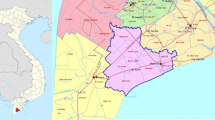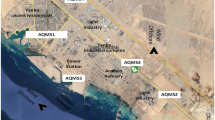Abstract
Air pollution is a significant environmental problem in Isfahan City, Iran, with detrimental effects on human health and ecosystems. It comes from various sources, including the asphalt industry, motor vehicles, power plants, industry, and natural events such as forest fires and dust storms. The data used in the study was obtained through a combination of different methods and strategies. Reliable laboratory information besides reports from the European Environmental Protection Organization, American Environmental Protection Organization, and Australian Environmental Protection Organization, standards from environmental organizations were used to determine emission coefficients. Questionnaires were prepared and referred to trade and industrial units to gather information on production and air pollutant emissions. Finally, statistical analysis and grouping methods were used to analyze the data. Based on average data of emission rate of different sources, prioritizing resulted in the identification of five main sources of gaseous pollutant including chemical industries, synthetic textiles, and pharmaceutical industries (7.36%), burning garden waste outdoors (7.68), brick kilns (12.43%), garbage center (15.78), and digestion of humans (45.68). Other 30 sources contribute less than 3%. Based on the results, it is obvious that CH4 only contributes 44% in gas emissions of Isfahan City followed by CO (23%), TSP (13%), MVOCS (9%), PM10 (2.17%), NH3 (1.96%), non-methane volatile organic compounds (1.89%), Nox (1.70%), PM2.5 (1.36%), SOx (0.89%), VOC (0.76%), and PM (0.03%).The results of the paper provide information on the major sources of air pollutant emissions in Isfahan City, including chemical industries, burning garden waste outdoors, brick kilns, garbage centers, and digestion of humans. It presents the average data of emission rates from different sources, helping in prioritizing and targeting specific sectors for reducing emissions. The study highlights the importance of considering both natural and anthropogenic sources of air pollution and the need for implementing strategies to obtain accurate information on emissions. The research contributes to the understanding of air pollution sources in Isfahan City, which can aid in developing effective measures for reducing pollution and improving air quality.






Similar content being viewed by others
Data Availability
Data sets generated during the current study are available from the corresponding author on reasonable request.
References
Abderrezak, Khelfi (2018). Sources of Air Pollution. 220–258. https://doi.org/10.4018/978-1-5225-3540-9.CH011
AlKheder, S., & Almusalam, A. (2022). Forecasting of carbon dioxide emissions from power plants in Kuwait using United States Environmental Protection Agency. Intergovern Panel Clim Change Mach Learn Methods Renew Energy, 191, 819–827. https://doi.org/10.1016/j.renene.2022.04.023
Balram Ambade, & Sankar, Tapan & Gupta, Mansi & Sahu, Lokesh. (2023). A comparative study in black carbon concentration and its emission sources in tribal area. Water, Air, & Soil Pollution. 234. https://doi.org/10.1007/s11270-023-06197-9
Binglin Zhang, Shasha Yin, Xuan Lu, Shefang Wang, Yifei Xu, Development of city-scale air pollutants and greenhouse gases emission inventory and mitigation strategies assessment: A case in Zhengzhou, Central China, Urban Climate, 48,2023,101419,
Campbell, P., Zhang, Y., Yan, F., Lu, Z., & Streets, D. (2018). Impacts of transportation sector emissions on future US air quality in a changing climate. Part I: Projected emissions, simulation design, and model evaluation. Environ Pollut, 238, 903–917.
Chandawat, D. K., Verma, P. U., Solanki, H. A., & Patel, Y. M. (2014). Role of total phenol in the resistance mechanism of plants against air pollution. Biolife, 2(2), 586–592.
Chen, X., Jiang, Z., Shen, Y., Li, R., Fu, Y., Liu, J., & Abad, G. G. (2021). Chinese regulations are working—why is surface ozone over industrialized areas still high? Applying lessons from Northeast US air quality evolution. Geophysical Research Letters, 48, e2021GL092816.
Chen Jie, Zhixin Liu, Zhengtong Yin, Xuan Liu, Xiaolu Li, Lirong Yin, Wenfeng Zheng, Predict the effect of meteorological factors on haze using BP neural network, Urban Climate 51, 2023, 101630, https://doi.org/10.1016/j.uclim.2023.101630.
Dan Tong, Qiang Zhang, Steven J, Davis Steven J, Davis Fe Liu, Bo Zheng, Guannan Geng, Tao Xue, Meng Li., Chaopeng Hong, Zifeng Lu., David G., Streets, Dabo Guan, Dabo Guan, Kebin He. (2018). Targeted emission reductions from global super-polluting power plant units. 1(1):59–68. https://doi.org/10.1038/S41893-017-0003-Y
de Miranda, R. M., de Fatima Andrade, M., Fornaro, A., Astolfo, R., de Andre, P. A., & Saldiva, P. (2012). Urban air pollution: A representative survey of PM25 mass concentrations in six Brazilian cities. Air Quality, Atmos Health, 5(1), 63–77. https://doi.org/10.1007/S11869-010-0124-1
DECI. (2023). Approved methods for the sampling and analysis of air pollutants (Guideline No.2–9–01) (p. 56). Department of Environment and Conservation of Iran.
Gao, Yang, Zhang, Lei, Huang, Aishi, Kou, Wenbin, Bo, Xin, Cai, Bofeng, & Jiabao, Qu. (2022). Unveiling the spatial and sectoral characteristics of a high-resolution emission inventory of CO2 and air pollutants in China. Sci Total Environ, 847, 157623.
Goyal Prachi, Sunil Gulia, and SK Goyal Identification of air pollution hotspots in urban areas an innovative approach using monitored concentrations data. Science of the Total Environment 798 (2021): 149143
Guo, B., Feng, Y., & Hu, F. (2023). Have carbon emission trading pilot policy improved urban innovation capacity? Evidence from a quasi-natural experiment in China. Environ Sci Pollut Res. https://doi.org/10.1007/s11356-023-25699
Han, Y., Park, B., & Jeong, J. (2019). A novel architecture of air pollution measurement platform using 5G and block chain for industrial IoT applications. Proc Comp Sci, 155, 728–733.
Jafarzadeh Haghighi Fard Nematullah , Ahmadreza Lahijanzadeh, Elham Khaksar and Siros Karimi, 2014, Improving the performance of the comprehensive air pollution reduction plan in Ahvaz city, the first international dust conference, Ahvaz, https://civilica.com/ doc/539551
Le, H. T. C. H., Dang, T. N., Ware, R., Phung, D., Thai, P. K., & Sly, P. D. (2021). Using the health beliefs model to explore children’s attitudes and beliefs on air pollution. Public Health, 196(4), 9. https://doi.org/10.1016/J.PUHE.2021.04.026
Li, C., Zhu, Q., Jin, X., & Cohen, R. C. (2022). Elucidating contributions of anthropogenic volatile organic compounds and particulate matter to ozone trends over China. Environ Sci Technol, 56(18), 12906–12916.
Li, X., Yang, L., Liu, Y., & Zhang, C. (2023). Xu Xiaohong, H Mao, T Jin, Emissions of air pollutants from non-road construction machinery in Beijing from, 2015 to 2019. Environm Pollut, 317, 120729.
McDonald, B. C., De Gouw, J. A., Gilman, J. B., Jathar, S. H., Akherati, A., Cappa, C. D., & Trainer, M. (2018). Volatile chemical products emerging as largest petrochemical source of urban organic emissions. Science, 359(6377), 760–764.
McLaren, Duncan. (2020). Quantifying the potential scale of mitigation deterrence from greenhouse gas removal techniques. Clim Chang, 162(4), 2411–2428.
Nazari S, Sohrabi-Kashani A, Davari S, Delavar, Moghaddam Z. Determination of CO2, SO2 and NOx emission factors in Irans thermal power plants comparing with North American countries. IJE ,2009 12 (3):25–36
Pandey, A., Brauer, M., Cropper, M. L., Balakrishnan, K., Mathur, P. P., Dey, S., & Dandona, L. (2021). Health and economic impact of air pollution in the states of India: The Global Burden of Disease Study 2019. Lancet Planetary Health, 5(1), e25–e38.
Sheng, Q., & Zhu, Z. (2019). Effects of nitrogen dioxide on biochemical responses in 41 garden plants. Plants, 8(2), 45.
Shivaraj, B. W., Manjunatha, C., Abhishek, B., Nagaraju, G., & Panda, P. K. (2020). Hydrothermal synthesis of ZnO nanotubes for CO gas sensing. Sensors Intl, 1, 100018.
Song, Qu., Fan, S., Wang, G., He, W., Kangli, Xu., Nie, L., Zhao, Y., Zhu, Q., Li, T., & Li, G. (2021). Air pollutant emissions from the asphalt industry in Beijing China. J Environ Sci, 109, 57–65. https://doi.org/10.1016/j.jes.2021.02.027
Tan, Z., & Yan, L. (2021). Does air pollution impede corporate innovation? Intl Rev Econ Fin, 76, 937–951.
Varshney, C. K., Garg, J. K., Lauenroth, W. K., & Heitschmidt, R. K. (1979). Plant responses to sulfur dioxide pollution. Cri Rev Environ Sci Technol, 9(1), 27–49.
Xue, Yifeng, Liu, Xinyu, Cui, Yangyang, Shen, Yan, Tongran, Wu., Bobo, Wu., & Yang, Xiaoyan. (2022). Characterization of air pollutant emissions from construction machinery in Beijing and evaluation of the effectiveness of control measures based on information code registration data. Chemosphere, 303, 135064.
Yao, Y., Li, X., Smyth, R., & Zhang, L. (2022). Air pollution and political trust in local government: Evidence from China. J Environ Econ Manag, 115,
Ying, Z., Xiaofan, X., Jianlei, L., Dongsheng, C., Shuiyuan, C., Lin, W., Xiao, W., & Chao, L. (2016). A comprehensive biomass burning emission inventory with high spatial and temporal resolution in China. Atmos Chem Phys, 17(4), 2839–2864. https://doi.org/10.5194/ACP-17-2839-2017
Zhao, R., Huang, X., Xue, J., & Guan, X. (2023). A practical simulation of carbon sink calculation for urban buildings: A case study of Zhengzhou in China. Sustain Cities Soc, 99, 104980.
Zhong, Z., Zheng, J., Zhu, M., Huang, Z., Zhang, Z., Jia, G., & Li, N. (2018). Recent developments of anthropogenic air pollutant emission inventories in Guangdong province, China. Sci Total Environ, 627, 1080–1092.
Zhou, Y., Xing, X., Lang, J., Chen, D., Cheng, S., Wei, L., Wei, X., & Liu, C. (2017). A comprehensive biomass burning emission inventory with high spatial and temporal resolution in China. Atmos Chem Phys, 17, 2839–2864. https://doi.org/10.5194/acp-17-2839-2017
Ziegler, I. (1975). The effect of SO2 pollution on plant metabolism. Residue Reviews: Residues of pesticides and other contaminants in the total environment (pp. 79–105). New York, NY: Springer, New York.
Acknowledgements
The authors will thank tremendous support and assistance of Research Center for Applied Plant Sciences of Arak Azad University.
Author information
Authors and Affiliations
Corresponding author
Ethics declarations
Conflict of Interest
The authors declare no competing interests.
Additional information
Publisher's Note
Springer Nature remains neutral with regard to jurisdictional claims in published maps and institutional affiliations.
Rights and permissions
Springer Nature or its licensor (e.g. a society or other partner) holds exclusive rights to this article under a publishing agreement with the author(s) or other rightsholder(s); author self-archiving of the accepted manuscript version of this article is solely governed by the terms of such publishing agreement and applicable law.
About this article
Cite this article
Yousefi, T., Varvani, J., Abad, B.S.E. et al. Integrated Study of Air Pollutant Emissions from Different Sources in Isfahan City of Iran. Water Air Soil Pollut 235, 194 (2024). https://doi.org/10.1007/s11270-024-06992-y
Received:
Accepted:
Published:
DOI: https://doi.org/10.1007/s11270-024-06992-y




